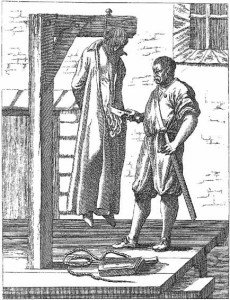 This post has kindly been written for us by IHR Digital intern Rebecca Gillard.
This post has kindly been written for us by IHR Digital intern Rebecca Gillard.
Since starting my studies as a History BA student I have become increasingly interested in the topic of crime and punishment. The site Connected Histories proved extremely useful due to its fruitful content. Connected Histories is a collection of twenty five digital resources which contain sources dating from 1500 to 1900 on numerous of different topics. The search can be tweaked to suit your needs, specifying whether you’re looking for a particular person or place.
I searched the keywords crime and punishment in order to test out Connected Histories, and see what resources it would bring up. This search brought up over 300,000 matches across twenty two different resources.
The most useful and interesting sources came from The Proceedings of the Old Bailey Online, which provides trial proceedings from one of London’s criminal courts during the late seventeenth century, up until the early twentieth century. When searching through numerous of trials you can see how punishments varied and how certain crimes were viewed differently. One interesting case I found was of a fourteen year old boy found guilty of stealing a milk pot and was sentenced to death in 1806. Another case, in 1678, was a man found guilty of manslaughter and whose punishment was a burn on the hand. This punishment seems a lot less severe than death, especially considering that manslaughter is often seen as a much more vicious crime than theft. The Proceedings of the Old Bailey Online provide an interesting insight into the criminal court and how over time the justice system was ever changing.
Witches in Early Modern England also provided numerous results. This resource contained case studies of individuals being trialled for witchcraft, detailing their crimes, victims and verdicts. This would prove extremely resourceful for someone who was interested in the topic of witchcraft, and would present a great starting point. As well as the short description of the event, it also contains the original text from the trail so you are able to read it in more detail, and get a sense of what type of language they used.
The Museum Image Collection Database and the Database of Mid-Victorian Illustration are two other resources which came up when doing when my search, showing how the sources are not just text documents. These resources show how crime and punishment was represented and viewed from 1500 to 1900. There is a wide variety of images ranging from political satire to pictures on the back of playing cards.
Due to the key words the search also pulled up Queen Victoria’s Journals, something which I did not expect to find. Looking through the diary entries I found it fascinating to read about a monarch’s life from their own perspective. The entries are so detailed and outline Queen Victoria’s feelings and thoughts during her most pivotal and also private moments. Even though I did not intend to find this upon my search it still proved a really interesting resource, despite not being entirely connected to my original topic.
Connected Histories is a valuable and useful tool for searching for a specific topic, area, person, or location. It provides numerous different avenues for you to explore, whether you’re searching for pictures or text documents, and allows you to make your own connections as well as look at ones which are already made. Connected Histories is a great resource to use for anyone wanting a wide variety of sources on an area in British History.
